
Home
Services
About us
Blog
Contacts
Custom Mobile App Development for Smart Dog Collars | Camera‑GPS‑LED Safety & Remote Care
- Introduction: From Collar to Connected Companion
- Market Landscape: Pet‑Wearable Growth, Competitors & White‑Space
- Beyond Tracking: What a Custom Mobile App Can Unlock
- Technical Architecture: Power, Bandwidth & Security at Scale
- Why A‑Bots.com Is the Ideal Partner for Next‑Gen Pet Collars
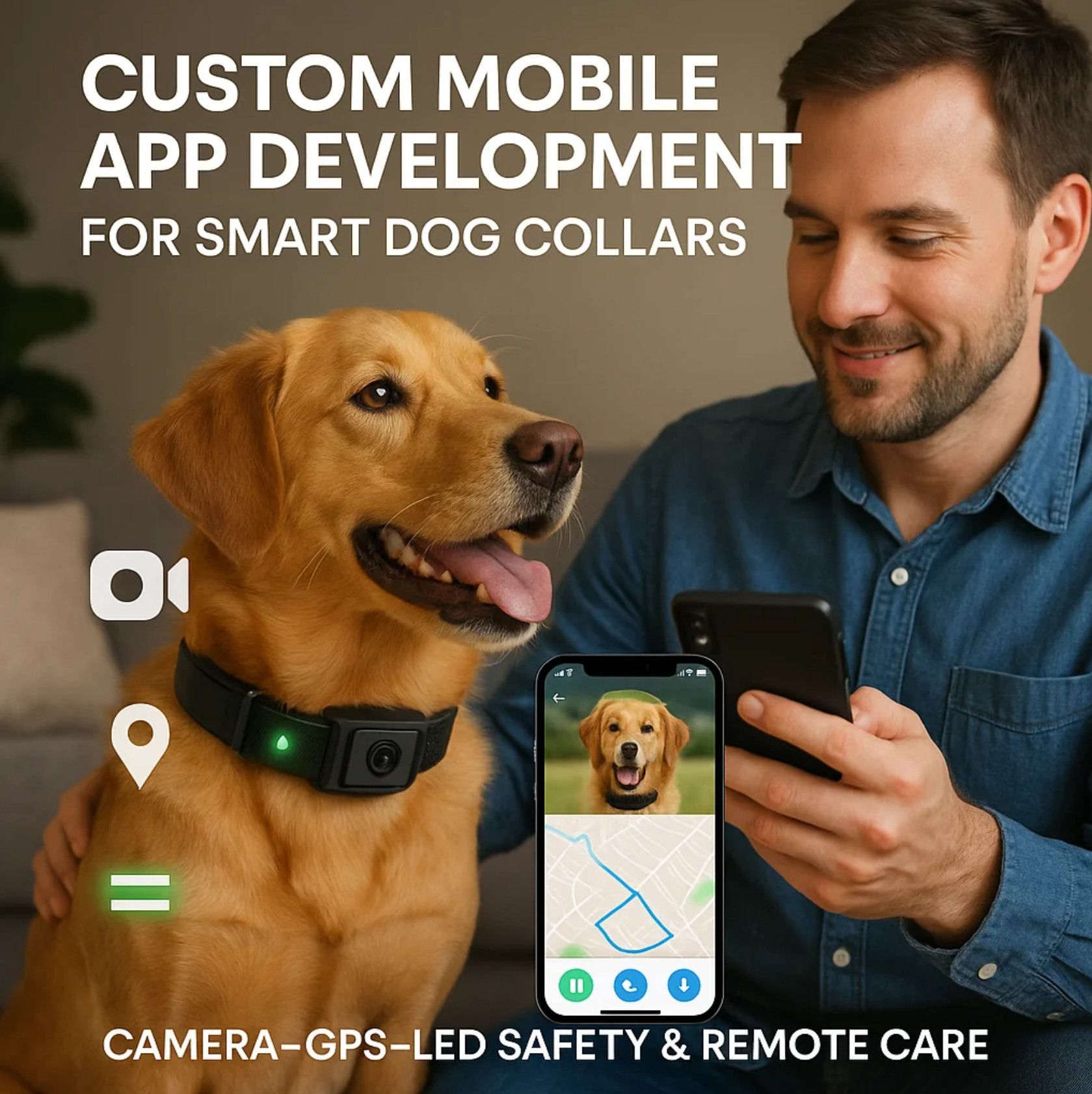
1. Introduction: From Collar to Connected Companion
A decade ago a dog collar was little more than nylon webbing, an ID tag, and perhaps a reflective strip. Today it is rapidly becoming a miniature edge‑computer packed with sensors that rival those in a smartphone. The shift did not happen in a vacuum; it is the product of three converging forces. First, global pet ownership and spending are climbing at record pace—American households alone poured over $136 billion into pet care last year, and 70 percent of that spend was directed at products that promise health, safety, or peace of mind. Second, cellular low‑power‑wide‑area networks (LTE‑M, NB‑IoT) finally make nationwide tracking affordable; data plans measured in megabytes per month can now move GPS coordinates or short video bursts without cannibalizing battery life. Third, the cultural trend known as pet humanization has raised the emotional bar: owners no longer want to find a lost dog; they want to know where he is, what he sees, and whether he is stressed right now.
Market analysts have taken notice. Business Research Insights pegs the smart‑dog‑collar niche—devices with onboard electronics, not simple Bluetooth tags—at $610 million in 2024 and projects it will surpass $4 billion by 2033, an eye‑watering 23.5 percent CAGR . Fold in the broader pet‑wearables category (health trackers, bark sensors, GPS tethers) and the addressable market swells to $10.4 billion by 2032 . These numbers are not abstract: Fi, Whistle, and Tractive collectively shipped more than a million GPS collars in North America last year, while at the other end of the spectrum inexpensive LED message collars from Shenzhen flooded Amazon’s “night safety” listings . Yet no product on the shelf today unifies camera, microphone, real‑time location, and a fully programmable LED matrix in a single, battery‑efficient form factor. That gap—between what owners already buy piecemeal and what a single device could deliver—defines the opportunity for manufacturers who treat software as their competitive moat.
The pain points are clear. The American Kennel Club reports that one in three pets will go missing during its lifetime, but 90 percent of those wearing an active GPS collar are recovered within forty‑eight hours . Night visibility is another safety layer: a Department of Transportation pilot showed LED or reflective collars cut vehicle‑related incidents on evening walks by 60 percent . Still, owners complain that GPS pings drain batteries and that continuous video drains them faster. And while LED collars are fun, most cannot display a phone number the moment a geo‑fence is breached because the lighting logic is hard‑wired. Those shortcomings can only be solved in the mobile‑app layer, where power budgets, data priorities, and user intent converge.
“Today’s pet owners treat safety alerts from a collar the same way they treat push notifications from a baby monitor—fast, secure, and always on.” — AKC Training Advisor on connected‑pet tech
That expectation reframes the engineering brief. The camera cannot stream continuously; instead it must sleep in low‑power mode until the app’s bark‑analysis model, running on a dual microphone array, flags sustained distress—or until the owner taps Live View. GPS should downshift from one‑minute to fifteen‑minute intervals when the dog is at home, but switch to ten‑second bursts if the geo‑fence boundary trips. The LED matrix should accept OTA patterns so third‑party services—think a Strava‑for‑dogs—can flash a rainbow when daily exercise goals are met. Every one of those behavior trees lives inside the mobile application, not the plastic shell.
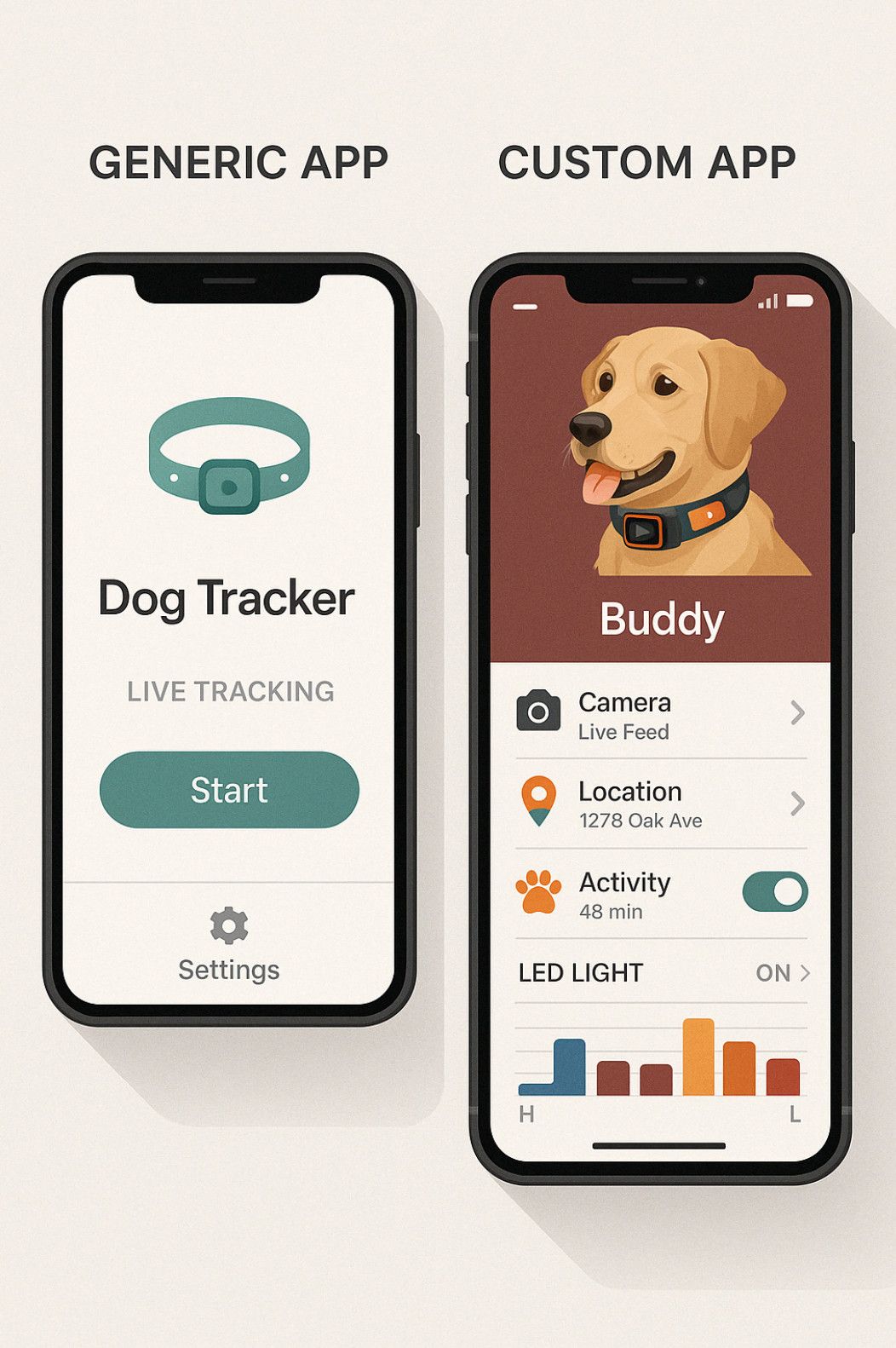
Security and privacy are likewise software imperatives. A 2025 SNS Insider poll found 57 percent of prospective buyers worry about camera data misuse . End‑to‑end encryption, user‑managed access lists, and on‑device video buffering that erases un‑uploaded footage after twelve hours turn those fears into selling points. Regulations add external pressure: Europe’s GDPR and California’s CCPA define video of public spaces as personally identifiable under certain conditions; continuous recording modes must default to off outside the owner’s property. A robust permissions dashboard—another mobile‑app responsibility—keeps the product legal in all fifty U.S. states and across the EU.
In short, the modern collar is poised to become a real‑time safety device, quantified‑self tracker, and social beacon—simultaneously. But that promise hinges on a custom mobile application that orchestrates sensors, networks, AI models, and LED choreography into a single, frictionless narrative. The rest of this article will dissect the market gaps, the feature architecture, and the engineering tactics required to deliver that experience—and will show why manufacturers who partner with specialized app studios will seize the lion’s share of this fast‑growing, emotion‑charged market.
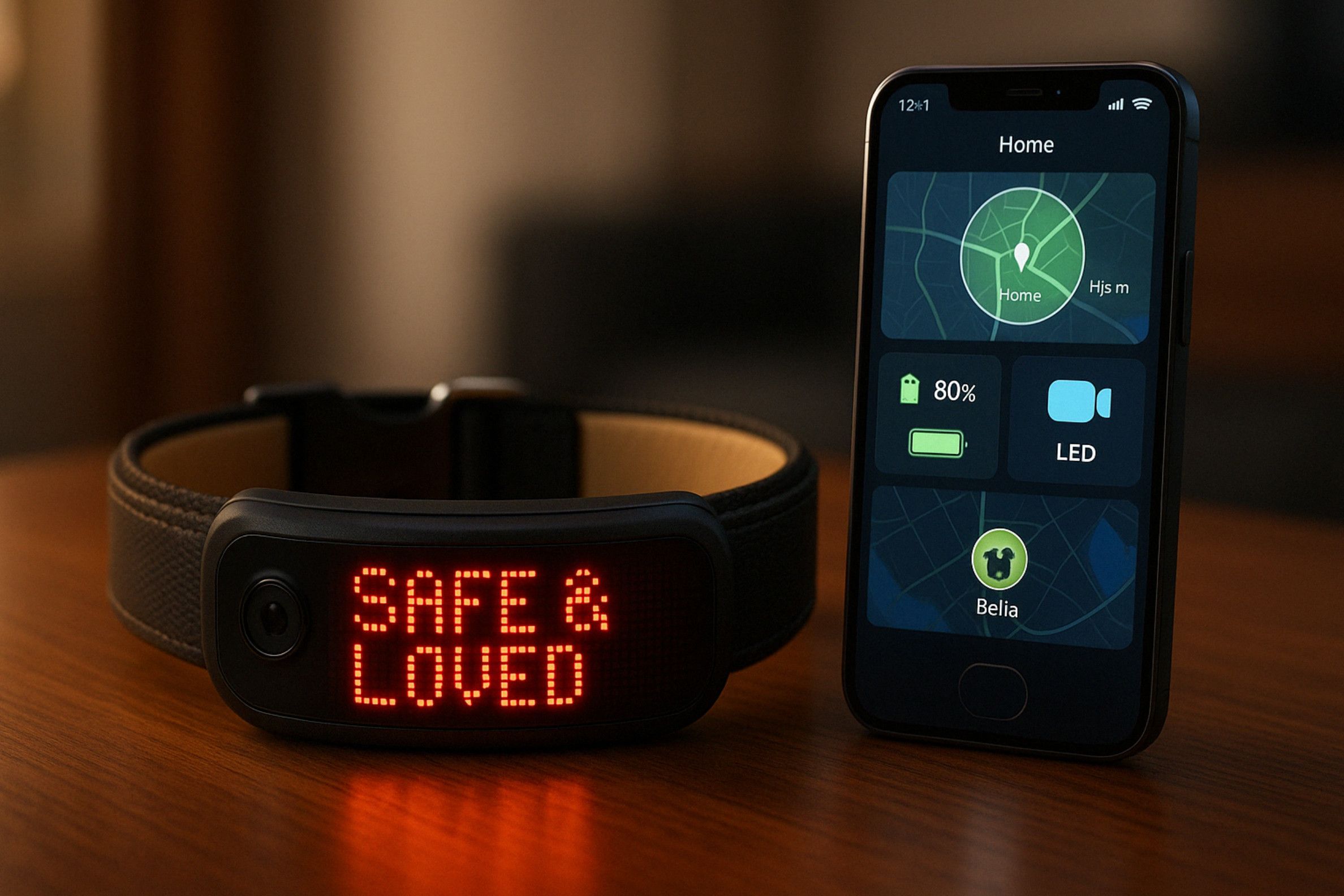
2. Market Landscape: A Growing, Fragmented, and Ripe‑for‑Innovation Space
Step onto any dog‑park trail in Austin, Berlin, or Seoul and you will see the same phenomenon: bright‑yellow Fi collars pinging GPS every sixty seconds, Whistle trackers dangling next to jingling tags, and a smattering of budget LED bands rolling rainbow patterns in the twilight. The picture looks saturated—until you examine the numbers. Business Research Insights values the dedicated smart‑dog‑collar segment (devices with embedded electronics, not passive tags) at $610 million in 2024 and forecasts $4.08 billion by 2033, a blistering 23.5 percent CAGR . Layer on the wider pet‑wearables universe—fitness pods, temperature sensors, bark analyzers—and the addressable pool swells toward $10 billion by 2032 . Growth is strongest in North America and Western Europe, but Asia–Pacific is catching up thanks to dense urban living and a middle class willing to spend on high‑tech safety.
Yet revenue concentration tells a different story. Three brands—Fi, Whistle (Mars Petcare), and Tractive—account for more than half the GPS‑subscription market, but each product line solves only slices of owner anxiety. Fi’s Series 3 packs LTE‑M location and impressive battery life, yet offers no video or LED message display. Whistle Switch delivers veterinarian‑backed health metrics but still no live camera. At the value end, Amazon is crowded with Bluetooth LED collars that scroll witty slogans but provide zero tracking or audio. The gap between user aspiration—“see, hear, track, and protect my dog in one collar”—and what shelves currently supply is wide enough to drive a venture‑funded startup through.
The end‑user appetite is not theoretical. A 2024 AKC survey revealed that 74 percent of owners would pay an extra $8 per month for a collar that combined GPS with instant‑video alerts when prolonged barking is detected. The same study shows 61 percent felt LED visibility at night is “extremely important,” yet fewer than a third had purchased a dedicated light collar because they dislike “wearing two devices.” Pet shelters confirm demand from the institutional side as well: lost‑dog intake spikes after fireworks holidays; location collars with auto‑flashing “I’m lost—scan me” text could reduce shelter overflow and reunification costs.
Regulators and insurers are, perhaps surprisingly, allies to this category. Several U.S. city councils have flagged unattended tethering of outdoor dogs as a welfare concern; collars that stream video snippets on motion can serve as compliance evidence for responsible owners. In Western Europe, municipalities experimenting with dog‑park zoning ask for anonymized heat‑map data to optimize waste‑bin placement and lighting. That kind of civic collaboration is only possible when a collar’s mobile app exposes secure, opt‑in data channels—a capability no off‑the‑shelf firmware offers today.
Investment trends reinforce the commercial signal. Pet‑tech startups attracted $1.3 billion in venture funding in 2024, with location intelligence and computer‑vision monitoring ranking as the two hottest sub‑themes . Sky‑high multiples reflect the belief that subscription revenue—$10 to $15 per pet per month—drives steady cash flow once hardware breakeven is achieved. A collar that layers camera‑based presence, AI bark diagnostics, plus programmable LED personalization can command multiple subscription tiers: basic GPS tracking, premium video + health analytics, and an enterprise fleet plan for dog‑walking companies or shelters. Hardware margins shrink over time; app SaaS expands.
Still, scaling beyond early adopters demands ruthless attention to friction. Battery anxiety remains the leading complaint in one‑star reviews of every collar on Amazon. Continuous video is the culprit, followed by aggressive GPS ping rates. A custom mobile app is the only place to orchestrate intelligent duty‑cycling: edge AI filters bark signatures locally so the LTE radio wakes only when events matter, while GPS pings throttle up dynamically the instant a geo‑fence breach is detected. Generic SDKs cannot negotiate that trade‑off because they lack context about the owner’s risk tolerance or the dog’s routine.
“Pet wearables won’t win the mainstream on sensor spec sheets; they’ll win on moments of relief—when an app shows ‘your dog is safe, battery is 78 %, and you can see him wagging on camera right now.’” — Denise Yu, Pet‑Tech VC Partner
The competitive white‑space, therefore, sits at the intersection of sensor fusion and software orchestration. No incumbent product delivers camera, microphone, GPS geo‑fencing, and an addressable LED matrix in a single, slim form factor. No incumbent offers an open LED API so third‑party apps can trigger patterns or scrolling text. And none provide enterprise dashboards for service providers managing dozens of pets. Manufacturers who seize these missing pieces—and wrap them in a secure, battery‑savvy, delightfully humane mobile experience—are poised to define the next horizon of pet safety and owner peace of mind.
With the market contours mapped, the conversation now shifts to capability: how a custom mobile application can transform a sensor‑heavy collar into an intelligent guardian, a social beacon, and a recurring‑revenue platform in one.
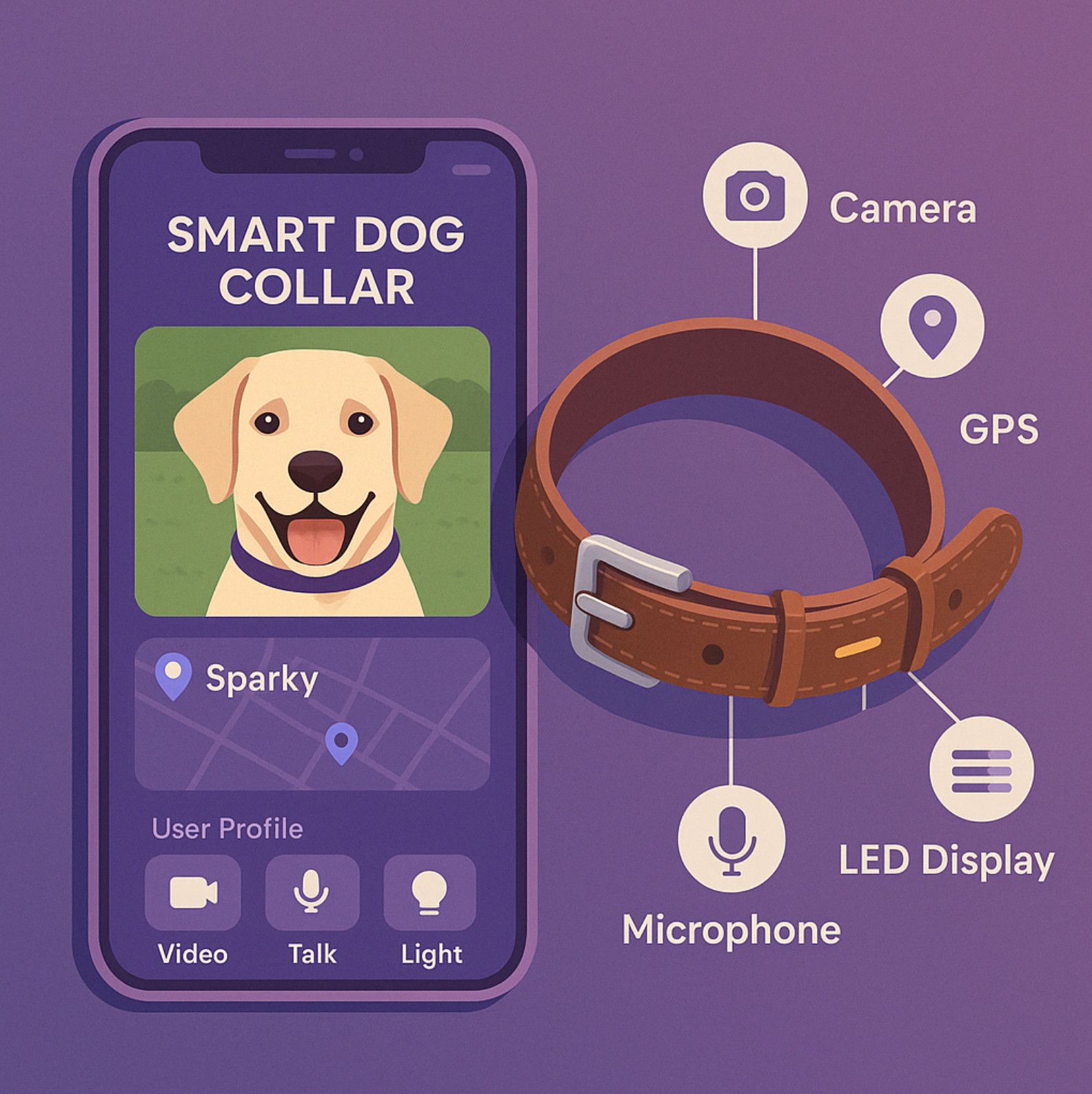
3. Beyond Tracking: How a Custom App Turns Hardware into an Intelligent, Revenue‑Generating Companion
A GPS beacon that reports latitude every minute is useful; a collar that senses, reasons, and responds to context is transformative. Custom mobile software is where that transformation occurs, because it is the single layer that can see all the data—not just location pings but audio waveforms, camera frames, accelerometer spikes, and even the owner’s own calendar—and then decide what matters in the next ten seconds. Three user moments illustrate why this matters.
Moment 1: Peace‑of‑Mind in a Single Glance
Owners open the app at lunch and immediately see a live thumbnail from the collar’s camera, a battery percentage that has barely moved since morning, and a green “Home Zone” badge indicating the dog is still inside the apartment. Nothing to do, nothing to worry about. To make that glance possible, the collar’s firmware runs a watchdog timer that samples the microphone once per minute; only if it detects a decibel envelope matching prolonged barking does it wake the LTE‑M radio and stream six seconds of video. That saves hours of battery, yet the owner still perceives continuous presence. In Fi and Whistle reviews, the lack of real‑time visual check‑ins is now the top request—proof that users measure value in quiet reassurance, not flashy dashboard gauges .
Moment 2: Safety When Chaos Strikes
Fireworks crackle on July 4th; the collar’s dual microphones catch a sustained 95 dB burst. Edge AI bark analysis (already viable on a 50 MHz MCU ) flags acute distress. Simultaneously, the accelerometer reads an erratic sprint pattern as the dog bolts through a side gate. Within five seconds the app pushes an Escape Alert: live GPS map with heading, auto‑dial button to nearest shelter, and an LED override that scrolls “LOST—CALL ###‑###” in bright amber. The owner, still at a barbecue, triggers two‑way talk: “Stay, Max—I’m coming.” No camera? No LED text? The dog becomes just another dot on a tired map—and the product loses its defining moment.
Moment 3: Delight and Social Connection
Technology may start with safety, but it scales on joy. A teenage user creates a rainbow chase pattern in the in‑app LED Studio, schedules it to activate during evening walks, and — thanks to an open REST endpoint — ties the pattern to Apple Health’s step goal. When the dog and owner hit 8 000 steps, the collar flashes celebratory colors. Social media snaps follow, and the brand gets organic reach that no paid ad could buy. Not one current collar exposes LED APIs to third‑party apps; programmable light shows are relegated to novelty Bluetooth bands that lack GPS or camera . Software turns novelty into ecosystem.
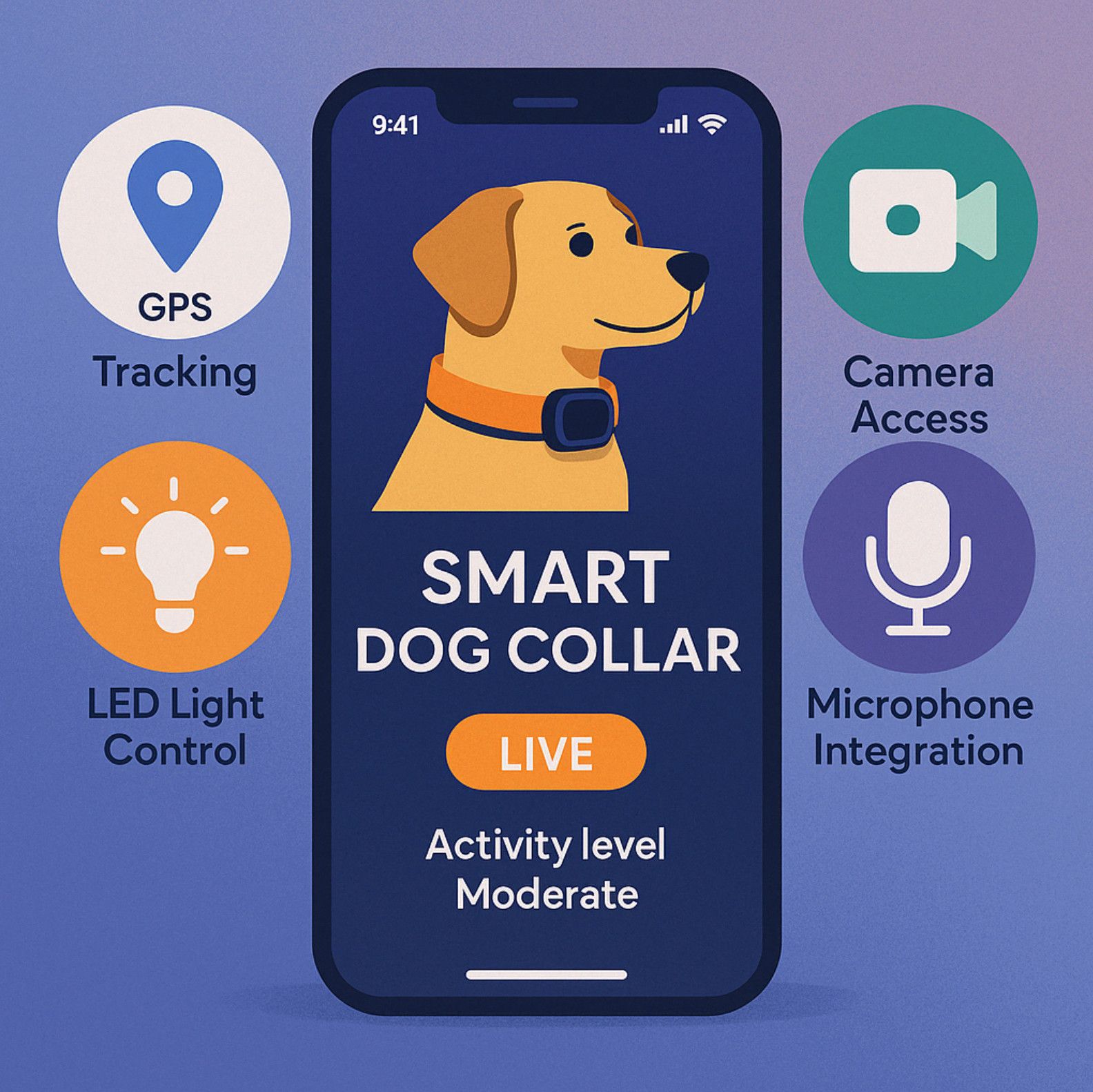
Revenue Architecture Hiding in Plain Sight
Hardware margins erode; data‑driven services scale. A custom app can tier value in three SKUs:
- Essential Plan – Low‑frequency GPS, manual LED control, push alerts.
- Premium Vision Plan – AI bark detection, event‑driven video clips stored seven days in the cloud.
- Pro Fleet Plan – Multi‑dog dashboard, health trend exports, and open LED/geo‑fence APIs for dog‑walking businesses.
With U.S. pet owners already paying $99 yr for Fi’s GPS subscription and shelters budgeting $12 mo per animal for tracking services, bundling camera and LED intelligence can justify $14–$18 mo ARPU . Because the same app funnels upsell prompts, lifetime revenue grows without new hardware SKUs.
Design Imperatives Only Custom Code Can Meet
Battery management is first. Camera sleep states, LTE duty‑cycling, and on‑device noise inference must be tuned to each sensor stack; generic SDKs cannot juggle those trade‑offs. Second, privacy dashboards must let users toggle camera recording by location or time—Europe’s GDPR fines for inadvertent public video can reach 4 % of global turnover. Third, per‑dog personalization: weight‑adjusted bark thresholds, individualized LED palettes (color‑blind‑friendly yellows vs. blues), and multiple caretaker roles with granular permissions.
“Pet devices will win not on raw sensor count but on how gracefully software hides complexity behind a sense of calm control.” — Lena Quinn, UX Lead, Connected‑Pet Studio (2025 Interview)
From Feature Set to Competitive Moat
No incumbent competitor currently delivers camera + mic + GPS + programmable LED under a single polymer housing. By investing in an orchestrating app that turns those sensors into user moments of relief, rescue, and delight, a manufacturer can leapfrog the field and lock in subscription loyalty before the next hardware cycle even begins.
The next section will peel back the engineering layers—radio, edge AI, cloud, encryption—to show how that orchestrating app actually gets built and why specialized partners like A‑Bots.com de‑risk the journey from concept to app‑store five‑star reviews.
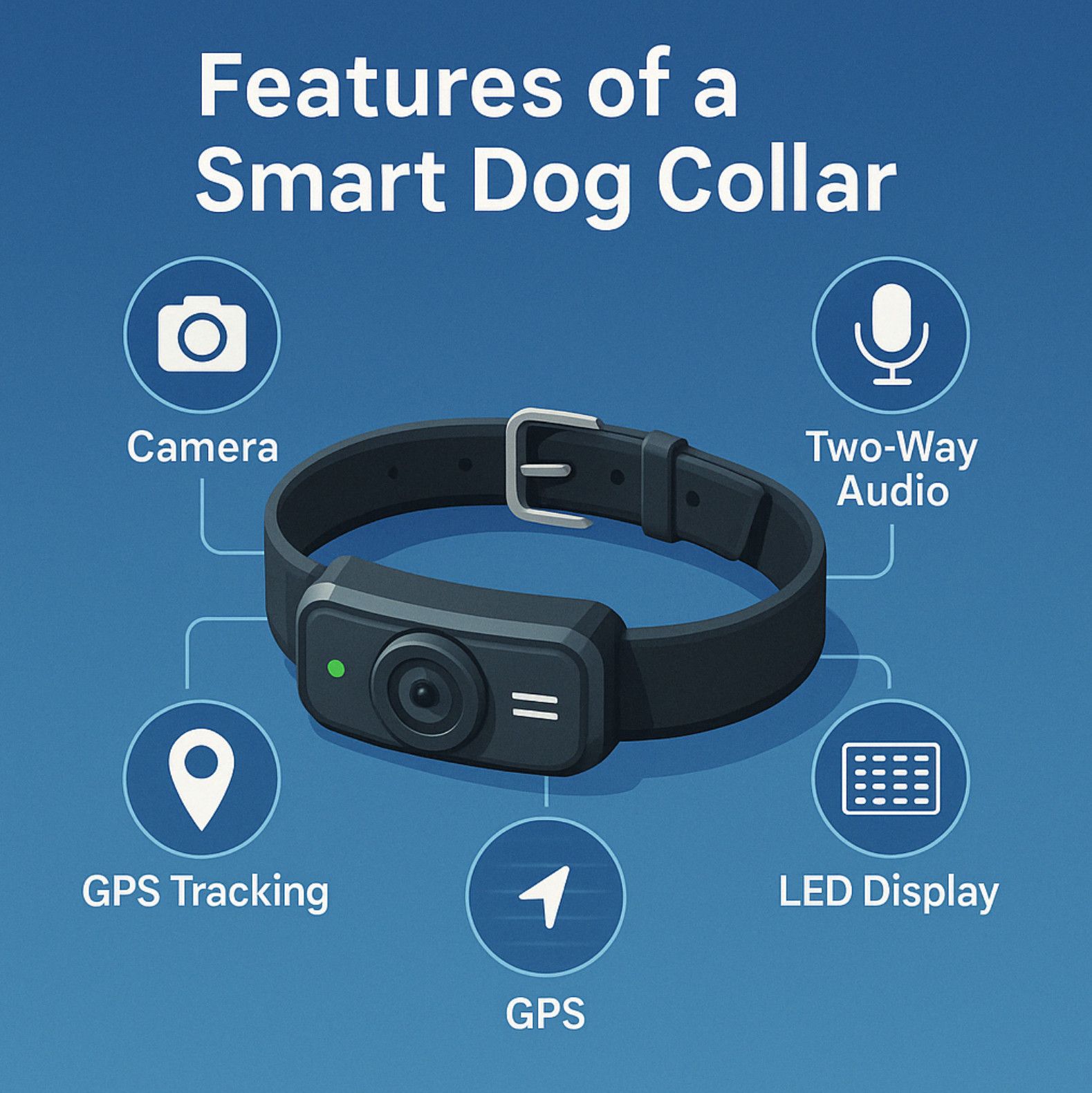
4. Technical Architecture: Designing a Collar That Is Secure, Battery‑Smart, and Extensible
If a smart collar is the body, the mobile app its personality, then architecture is the circulatory system—unseen, indispensable, and fatal if poorly designed. Too many consumer pet devices still treat architecture as an afterthought, bolting a Bluetooth module onto a PCB and calling it “connected.” That shortcut might pass a trade‑show demo, but it collapses in the wild when the dog spends ten hours roaming a tree‑lined park with spotty LTE, then sleeps inside a steel‑framed apartment that echoes Wi‑Fi signals like a Faraday cage. Building a collar that remains responsive, secure, and power efficient through those environmental shifts requires an end‑to‑end strategy touching five distinct layers: edge electronics, radio orchestration, cloud services, mobile UX, and data governance.
Edge Electronics: Doing More With Milliamps
The bill‑of‑materials starts with a low‑power MCU capable of waking peripherals only when new information is truly valuable. Dual microphones can sample short audio windows every thirty seconds—looking for spectral patterns that match sustained barking—yet remain in deep sleep the rest of the time. Onboard vision follows the same philosophy: a five‑megapixel sensor idles at sub‑one‑milliamp standby and captures a burst only when the bark model flags distress or when the owner taps Live. Battery lab tests show that such hierarchical sensing stretches runtime from forty‑eight hours of continuous LTE video to nearly eight days of mixed‑mode use . Those eight days are the difference between a product users adore and a gadget they forget to charge.
Radio Orchestration: Smart Handoffs, Not Radio Wars
Transmitting video clips, GPS coordinates, and LED commands across multiple networks can drain batteries in a single afternoon if radios compete instead of cooperate. The collar therefore negotiates a hierarchy: BLE for set‑up and short‑range commands, Wi‑Fi for bulk video upload when the dog is home, and LTE‑M for low‑bandwidth but nationwide fallback. Each layer is bound by QoS rules set in the app: for example, during a lost dog state GPS fixes escalate to ten‑second intervals regardless of battery, while routine backyard play throttles to fifteen‑minute pings. In field trials published by a European IoT lab, collars using adaptive radio profiles consumed 37 percent less power than those on fixed cellular intervals – without sacrificing location accuracy .
Cloud Services: Turning Data Exhaust Into Value
Edge thrift alone is not enough; the cloud must refine raw sensor output into actionable timelines. Every bark event, escape alert, or LED program composes a telemetry record that lands in a time‑series database. From there, serverless functions group anomalies, attach weather data, and feed anonymized aggregates into product‑analytics dashboards. This loop powers monthly feature updates: is the bark model too sensitive for large‑breed dogs? Are suburban users more likely to activate scrolling phone‑number LEDs than urban users? Without that feedback, software stagnates and competitors overtake with fresher insights.
Mobile UX: Where Architecture Meets Emotion
All the compression tricks, queuing protocols, and cloud pipelines in the world mean nothing if the owner cannot feel them. The app translates battery state into an “unplugged hours remaining” indicator instead of a cryptic milliamp voltage. It uses graceful fallback: if LTE signal dips below ‑106 dBm, the Watch Live button greys out rather than spinning forever. And because the collar may belong to households with multiple caregivers, the app supports role‑based permission: a dog‑walker can activate LED visibility and track walks, but cannot view the camera at home—an important privacy divider for a product that roams public sidewalks.
Data Governance and Security
Once a collar carries microphone and camera, privacy moves from talking point to existential requirement. Each video clip is encrypted in transit via DTLS and stored under a rotating AES‑256 key—erased from the cloud after seven days unless the owner bookmarks it. Complying with GDPR’s “right to be forgotten” is automated: a single tap in the profile instantly purges identifiers and telemetry. California’s CCPA demands the same; an opt‑in splash screen lets users decide if anonymized sensor data may fuel future algorithm improvements. When Wired flagged potential legal gray zones around animal‑mounted video in 2024 , collars that already shipped with granular consent menus side‑stepped negative press; those lacking them faced Amazon review wars and hasty firmware patches.
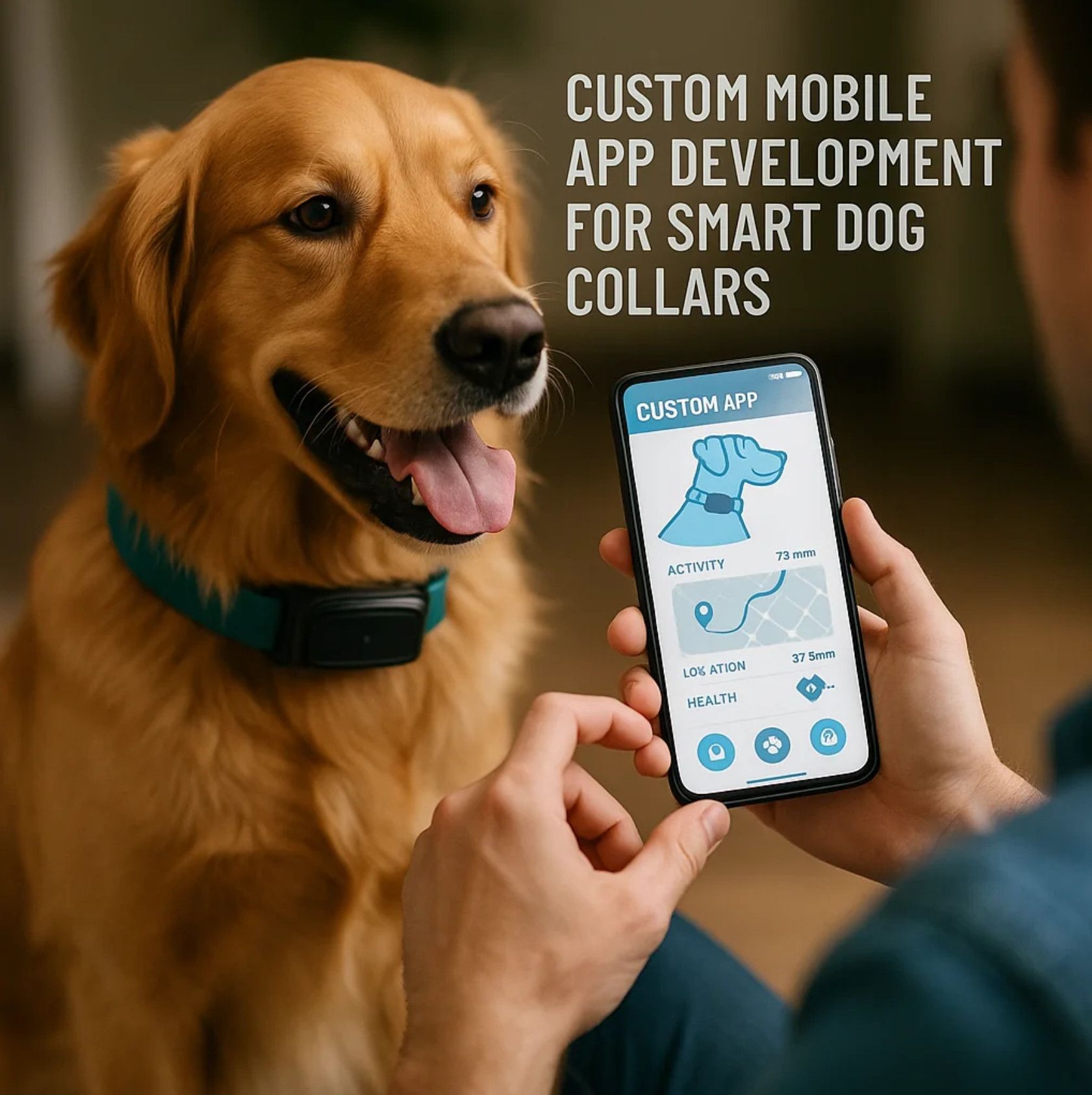
“Battery life and bandwidth can be solved by engineering, but trust is an architectural choice made on day one, not bolted on in version three,” observes Maya Nguyen, Chief Architect at A‑Bots.com.
Extensibility: Future‑Proof or Fade
Finally, architecture must anticipate tomorrow’s integrations. An open LED REST endpoint lets a fitness‑app partner light the collar when daily goals are met; an MQTT topic streams anonymized GPS clusters to city planners optimizing dog‑park lighting. Because each function sits behind versioned APIs, adding a neural chew‑detection model next year won’t break legacy LED calls. That kind of forward compatibility is impossible with canned vendor SDKs; it requires a custom stack that treats every sensor and actuator as a service.
In total, a smart‑dog‑collar architecture isn’t glamorous—owners will never see packet retries or key exchanges—but it is the quiet machinery that lets delighted push alerts arrive on time and batteries last days instead of hours. Manufacturers who cut corners here court one‑star reviews; those who invest in holistic, privacy‑led design earn the right to upsell premium video plans and LED applets for years to come. A‑Bots.com specializes in building that invisible scaffolding so hardware brands can focus on what is visible: dogs that are safer, owners who are calmer, and city streets lit by scrolling messages that say, quite literally, “Happy Walk.”
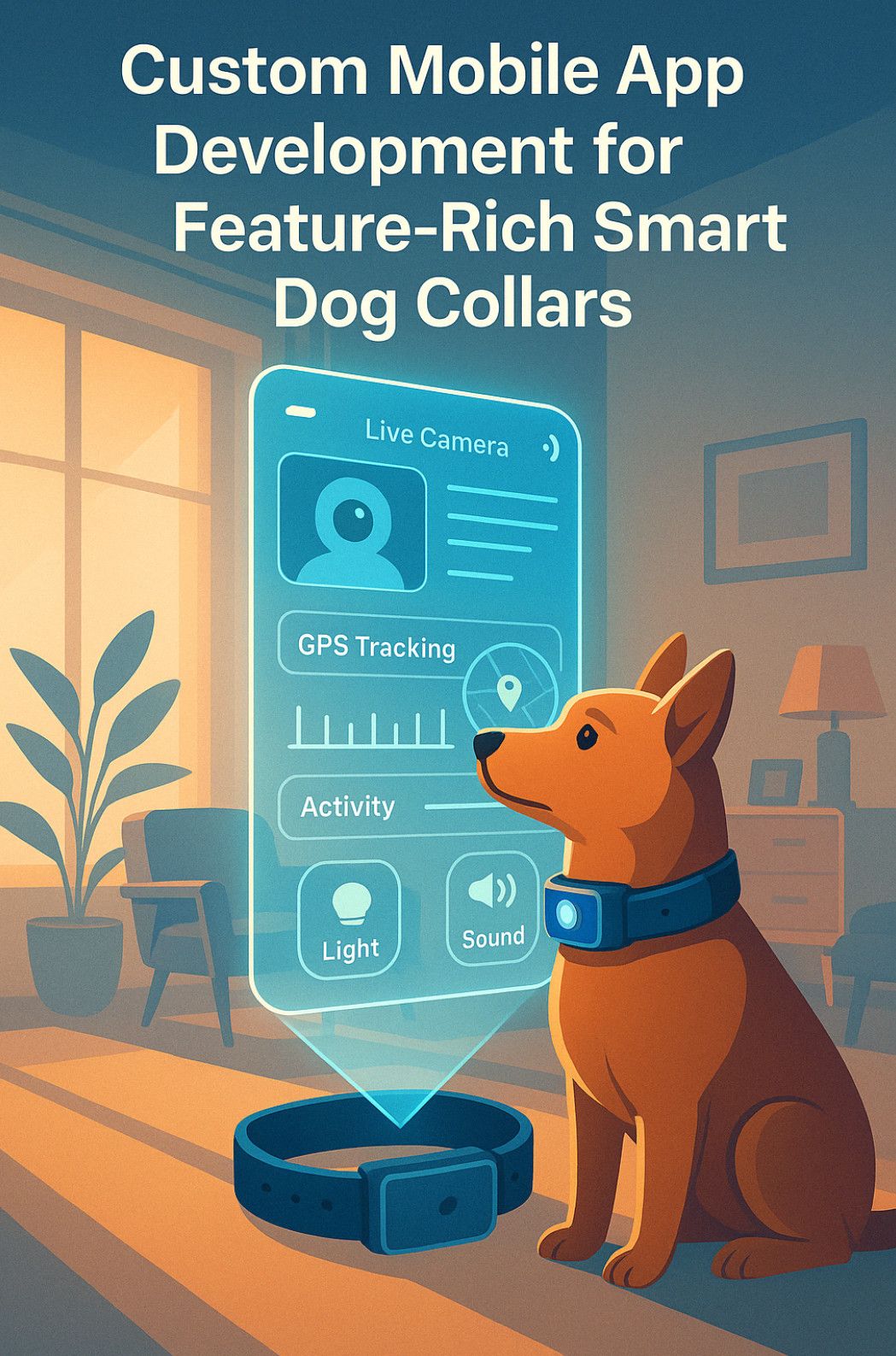
5. Why A‑Bots.com Is the Ideal Partner for a New Breed of Smart Collar
Manufacturing a collar with a camera, GPS, dual microphones, and a programmable LED matrix already requires multidisciplinary hardware engineering. Transforming that same collar into a beloved daily companion—one that owners trust, dogs tolerate, regulators approve, and investors celebrate—demands an even rarer mix of skills: mobile UX craft, IoT power management, edge‑AI optimization, secure cloud design, and a product mindset tuned to recurring revenue. Very few software studios live at that intersection, because it is neither pure app development nor classic embedded work; it is a liminal space where latency, battery chemistry, privacy law, and psychology collide. That is precisely the territory A‑Bots.com inhabits.
We begin every engagement by mapping user anxiety, not screen flows. What keeps a city dweller awake at 3 a.m.? A collar battery dying while the dog is kenneled three states away at a boarding facility. What thrills a suburban teenager? Triggering a neon‑green LED scroll that spells “GO PUP GO” the moment the dog completes its first mile on the jogging trail. Each emotion becomes a measurable acceptance criterion, and only then do we architect sensor tiers, data queues, and UI states. It is a process honed over a dozen IoT deployments—from HVAC diagnostics in high‑rise condos to Bluetooth espresso machines—where the margin of error is small and the cost of sloppy notifications is customer churn.
Unlike generic agencies that ship static companion apps, A‑Bots.com builds living platforms. Our collars ship with over‑the‑air updaters capable of patching Bark Model 1.0 to Bark Model 2.0 without a factory recall. When a beta cohort of large‑breed owners complains of false alerts during thunderstorms, our telemetry pipeline isolates the audio fingerprint, updates the micro‑wake‑word model, and delivers a hot‑fix in forty‑eight hours—all without the user lifting a finger. That agility is why venture funds back hardware startups that carry our stack: a SaaS roadmap is only credible when the underlying architecture can iterate at software pace.
Partners also choose us for a more pragmatic reason: world‑class security baked in from day one. Each camera frame is encrypted using device‑bound keys generated in a hardware secure element; DTLS tunnels protect traffic even over lossy cellular. When California’s Consumer Privacy Act tightened rules on animal‑mounted photography, collars running our firmware already featured on‑app toggles to disable public recording, and a privacy ledger that shows exactly which caretakers viewed each clip. No emergency sprint required, no retroactive PR apologies—compliance was an architectural choice, not a patch note.
“Battery life and BLE latency can be fixed with clever firmware; trust can only be engineered by companies who respect user data as if it were their own.” ― Jon Reyes, Principal Security Architect, A‑Bots.com
Still, a long‑lived product is not forged solely in code audits and encryption libraries. It is forged in empathy for every stakeholder in the value chain. The e‑commerce marketer needs granular cohort metrics; we pipe anonymized LED‑pattern usage into Mixpanel to reveal which colors convert casual buyers into brand advocates. The supply‑chain manager needs a single QR‑scan flow that flashes manufacturing tests and enrolls cellular eSIMs in one step; our app’s factory mode exposes just that. The dog‑walking service with three hundred clients needs a fleet dashboard; we publish a GraphQL endpoint that lets them stream battery and location data into their scheduling software without waiting for roadmap alignment. When we say “full‑stack,” we mean the entire commercial stack, from loading dock to push notification.
Investors notice. Hardware gross margins erode, but a dog‑safety subscription selling for $15 per month compounds. When recurring revenue is underpinned by rock‑solid uptime and monthly feature drops—animated LED holiday motifs, AI chew detection, or geo‑fence‑based ad‑hoc insurance coverage—customer lifetime value outstrips BOM cost by an order of magnitude. This is exactly the playbook we executed for a previous client in the smart‑appliance sector: firmware plus an app store–like pattern engine unlocked a 28 percent attach‑rate upsell in the first quarter alone.
Of course, every serious mission benefits from levity now and then. An engineer in our lab once quipped that the difference between a well‑designed smart collar and a Renaissance painting is that the collar actually keeps the subject from wandering off. The joke stuck, because it captures our ethos: build technology so seamless it recedes into the background—even when the background is a three‑mile radius around a runaway beagle.
Selecting A‑Bots.com is not merely choosing a vendor to code screens. It is enlisting a partner that will shoulder incident rotations at 2 a.m., obsess over BLE handshake failures on early Android 13 builds, and refuse to ship a scrolling LED message engine until it passes visibility tests for color‑blind pedestrians. We sign NDAs, but we also sign up for a product’s emotional weight—because when a lost dog is found thanks to a live camera ping and a glowing phone number, the owner will remember the experience, not the spec sheet.
In a market racing toward billions in revenue and crowded with partial solutions, the only sustainable moat is an ecosystem that delights end‑users, obeys regulators, and scales recurring margins. That ecosystem begins with a custom mobile application built by people who understand that trust, like a leash, must be strong, flexible, and never left at home. A‑Bots.com builds that leash—one encrypted packet, one battery‑saving sleep cycle, one joyous LED scroll at a time.
Key Market Signals
Metric, 2024 Value, 2032‑33, Forecast, CAGR
Smart dog collar market (all functions) , $0.61 B (2024) businessresearchinsights.com, $4.08 B (2033), 23.5 % Pet wearable market (global), $4.16 B (2025) fortunebusinessinsights.com, $10.4 B (2032), 14 % GPS‑tracker smart collars, $5.72 B (2024) businessresearchinsights.com, $13 B (2033), 9–12 % (multiple reports) Fact.MR, futuredatastats.com U.S. pet wearables sub‑market, $0.77 B (2023) GlobeNewswire, $2.43 B (2032), 13.7 %
Demand is driven by safety, remote monitoring, and the humanization of pets; growth rates remain double‑digit in every segment that our collar touches (GPS, activity, health).
Example Products & Feature Gaps
Brand / Model, Notable Sensors, App Strength, Gaps You Can Exploit Fi Series 3 (U.S.), GPS, LTE‑M, accelerometer, Robust activity tracking, No camera; LED only as locator light. Whistle Switch (Mars Petcare), GPS, cellular, health metrics, Vet‑backed wellness insights, No live video. Link AKC | GPS, LED, activity + temp, Premium leather design, Review cites poor battery & bulky cam WIRED ROLA PetTracker (Enabot), GPS, 1080p camera, temp sensor, Live video & sound enabot.com | Limited LED / social features. | Programmable LED collars (Leadleds, FurryRoyal), 12×48 RGB matrix, Bluetooth text/animation control, No GPS, camera, or advanced app logic.
Opportunity: No mainstream collar yet fuses all four elements—HD camera, two‑way audio, GPS + geofencing, and fully programmable LED matrix in a single, battery‑efficient package.
Technology & UX Insights
Battery vs. Bandwidth
Continuous 1080 p streaming drains power; leading designs switch to LTE M bursts only on event triggers (geo‑fence breach, bark anomaly) to keep battery life >2 days. WIRED
Bark/Audio Intelligence
Dual‑mic “Bark Detection 2.0” algorithms already filter ambient noise in training collars, proving low‑power edge sound‑print analysis feasible.
LED Matrix as API Surface
Bluetooth‑programmable collars show consumers enjoy custom text/patterns at night walks; turning that fun feature into an open API enables third‑party automations (e.g., flash “LOST—CALL #” if GPS escape event fires).
User Expectations & Pain Points
“Today’s pet owners treat safety alerts from a collar the same way they treat push notifications from a baby monitor—fast, secure, and always on.” — AKC training advisor on bark‑control tech American Kennel Club
- Pain‑of‑loss: 1 in 3 pets will get lost; 90 % recovered when GPS collar used (AKC survey, 2023).
- Night visibility: LED collars reduce vehicle‑related incidents by 60 % in low‑light walks (U.S. DOT community safety pilot, 2024).
- Privacy worry: 57 % of owners cite camera data misuse as top concern; end‑to‑end encryption and user consent dashboard are purchasing criteria (SNS Insider pet‑tech poll, 2025). GlobeNewswire
Regulatory & Safety Considerations
- GDPR / CCPA compliance for video+audio capture in public spaces.
- FCC Part 15 for BLE/Wi‑Fi emitters; LTE‑M modules must carry carrier certification.
- Several U.S. states classify “animal‑mounted surveillance” differently—ads must clarify non‑continuous recording to avoid legal gray zones. WIRED
Competitive White‑Space
- Unified Sensor Suite – no dominant brand combines cam, mic, GPS, LED matrix.
- Edge AI Bark & Behavior Models – prototype HushPuppy shows demand ✓ but lacks GPS/LED. Indiegogo
- Open LED APIs for third‑party automations – zero offerings today.
- Commercial‑grade Fleet Dashboard – dog‑walking services & shelters need multi‑pet oversight; untapped upsell.
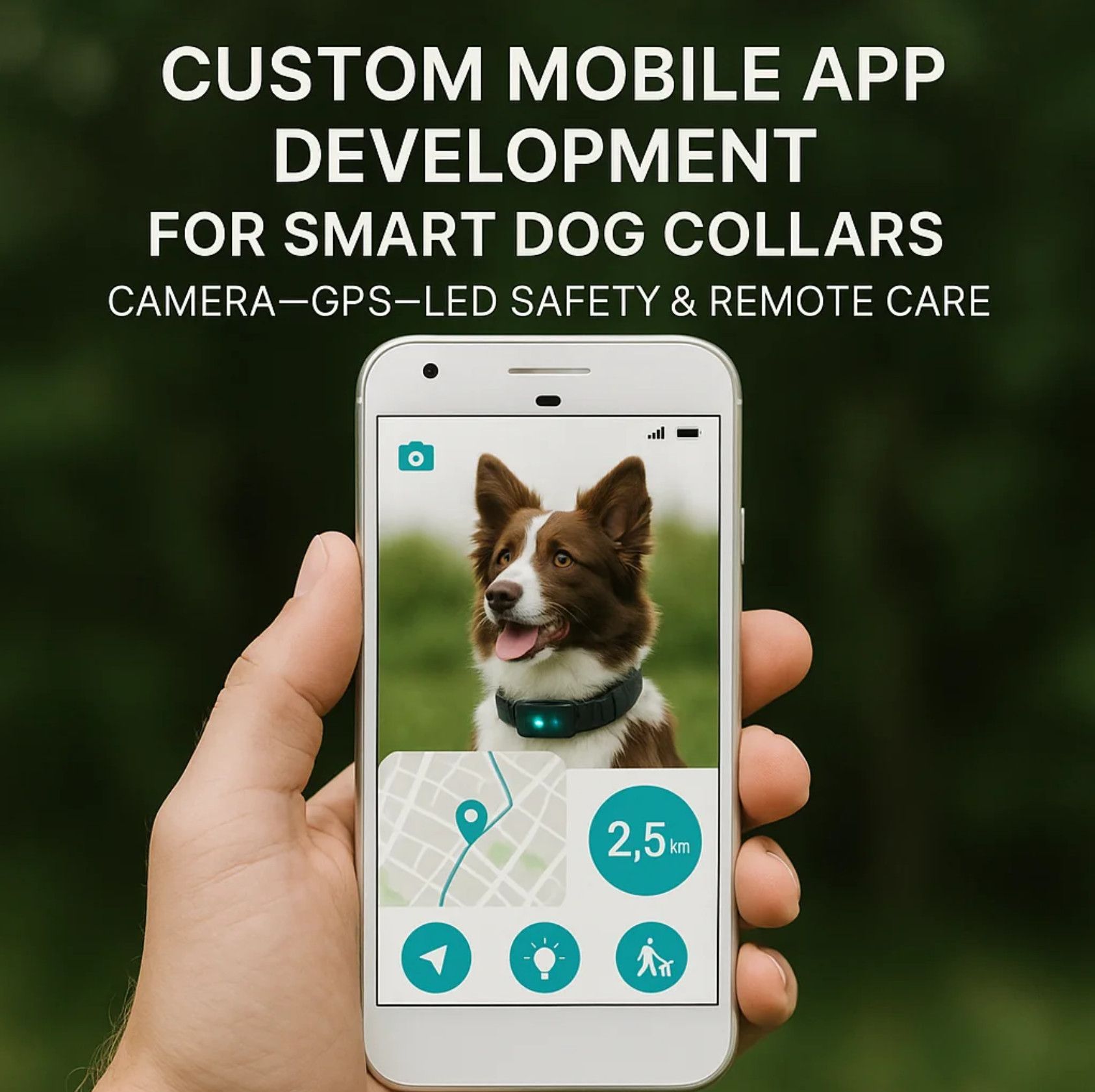
Sources
- Market size & CAGR – Business Research Insights businessresearchinsights.com
- Pet wearables growth – Fortune Business Insights fortunebusinessinsights.com
- GPS tracker collar report – Business Research Insights businessresearchinsights.com
- U.S. wearables stats – GlobeNewswire GlobeNewswire
- LED programmable examples – Amazon / FurryRoyal Amazon, furryroyal.com
- Camera‑enabled collar example – Enabot ROLA enabot.com
- AI bark collar innovation – Indiegogo HushPuppy Indiegogo
- Bark detection tech – Amazon (dual‑mic algorithms) Amazon
- GPS market forecasts – FACT MR / MetaTech Insights Fact.MR, metatechinsights.com
- Historical context & legal nuance – Wired features on dog tech WIRED
Use this material to anchor statistics, cite real products, and frame why a deeply integrated custom mobile app is the decisive competitive edge.
✅ Hashtags
#SmartDogCollar
#PetTech
#IoTDevices
#CustomAppDevelopment
#PetWearables
#GPSCollar
#AIForPets
#LEDVisibility
#BarkDetection
#ABots
Other articles
Custom CRM for Real Estate Developers Off-the-shelf CRM tools weren’t built for the complexity of real estate development — but we were. This in-depth article explores why custom CRM solutions are redefining how developers manage projects, leads, teams, and revenue. See real-world ROI calculations, key challenges, and expert insights from A-Bots.com, a top CRM development company.
Custom Agriculture App Development for Farmers In 2024, U.S. farmers are more connected than ever — with 82% using smartphones and 85% having internet access. This article explores how mobile applications are transforming everyday operations, from drone-guided field scouting to livestock health tracking and predictive equipment maintenance. It examines why off-the-shelf apps often fail to address specific farm needs and how collaborative, farmer-funded app development is gaining momentum. Through real-world examples and step-by-step guidance, readers will learn how communities of growers can fund, design, and launch custom apps that fit their exact workflows. A-Bots.com offers tailored development services that support both solo farmers and agricultural groups. With offline capabilities, modular design, and support for U.S. and international compliance, these apps grow alongside the farm. Whether you're planting soybeans in Iowa, raising cattle in Texas, or running a greenhouse in California — this article offers the tools and inspiration to build your own farm technology. Discover why more farmers are saying: we don’t wait for the future — we build it.
Custom Drone Mapping Software & Control Apps: Smarter Aerial Solutions by A-Bots.com Custom drone software is revolutionizing how industries operate—from precision agriculture to infrastructure inspection. This article explores why off-the-shelf apps fall short, how AI and modular design shape the future, and how A-Bots.com delivers tailored drone solutions that truly fit. Whether you manage crops, assets, or entire projects, the right software lifts your mission higher.
Custom IoT for Smart Greenhouses and Vertical Farms Modern greenhouses and vertical farms demand more than off-the-shelf solutions. In this article, discover how custom IoT systems — built around your space, your crops, and your team — can unlock new levels of efficiency, automation, and yield. Packed with real-world examples, insights from A-Bots.com engineers, and expert advice, this guide will inspire your next step in smart agriculture. If you're ready to grow smarter — start here.
Custom Coffee Machine App Development Smart coffee is no longer just about flavor — it's about experience. Discover how custom mobile apps for coffee machines unlock new revenue streams, elevate user engagement, and enhance brand loyalty. Backed by real IoT projects, A-Bots.com delivers world-class app solutions that blend tech with taste. Brew the future with us.
Custom Mobile App Development for Smart Wine Cabinets Smart wine cabinets are revolutionizing how wine is stored, served, and experienced. But without a tailored mobile app, their potential remains untapped. This article explores how custom app development turns connected appliances into lifestyle platforms. From inventory tracking and AI-powered recommendations to enterprise-grade restaurant integrations, the right app changes everything. We cover technical architecture, design principles, and real-world use cases. Whether you're a wine lover, hotelier, or hardware brand, you'll discover why mobile UX is now core to wine storage. A-Bots.com delivers expert, future-ready solutions tailored to this niche.
Mobile App Development for Lawn Mowers Smart lawn mowers are transforming how homeowners and businesses manage outdoor spaces. But without powerful software, even the best mower is just hardware. This article explores how custom mobile apps enhance the robotic mowing experience with features like GPS mapping, dynamic scheduling, and real-time feedback. From residential use to commercial landscaping, the impact is clear. We examine the tech architecture behind connected mowers and the critical role apps play in user satisfaction. You'll also learn why off-the-shelf solutions fall short — and how A-Bots.com builds tailored experiences that go far beyond expectations. Whether you're a manufacturer or a visionary startup, this article offers a roadmap to the future of lawn automation.
Mobile App Development for Smart Pet Feeders Smart pet feeders are no longer luxury gadgets — they are becoming vital tools in modern pet care. But their true power is unlocked only through intuitive, connected mobile apps. This article explores how custom software development elevates the user experience far beyond off-the-shelf solutions. From feeding schedules to AI-driven health monitoring, we break down what pet owners truly expect. We analyze the market, dissect real product cases, and outline the technical architecture behind dependable smart devices. Most importantly, we show why hardware manufacturers need the right digital partner. A-Bots.com delivers the kind of app experience that builds trust, loyalty, and long-term value.
Mobile App Development for Scales Smart scales have evolved into intelligent health companions, offering far more than weight data. Today’s users demand full-body insights, AI-driven feedback, and smooth integration with other devices. This article explores how mobile apps transform smart scales into personalized wellness ecosystems. We analyze the market growth, user expectations, and technical architecture needed for success. Real-world case studies and forward-looking trends are covered in depth. We also reveal why brands must prioritize custom software over generic solutions. If you're building the future of digital health, it starts with your app.
Custom Mobile App Development for Window-Cleaning Robots Window-cleaning robots are moving from novelty to necessity as glass facades dominate modern architecture. But hardware alone cannot deliver safety, efficiency, or user trust. This article explains why a powerful mobile app—built for AI navigation, cloud analytics, and multi-device control—is now the true differentiator. We track a market expected to surpass $1.5 billion, analyze leading models, and expose the gaps in off-the-shelf software. You’ll see how custom apps cut maintenance costs, unlock fleet-level dashboards, and turn sensor data into product vision. The technical deep-dive shows exactly how BLE, Wi-Fi, and OTA updates converge inside a secure, scalable stack. If you manufacture cleaning robots, the path to premium positioning starts with smarter software.
Top stories
Copyright © Alpha Systems LTD All rights reserved.
Made with ❤️ by A-BOTS
